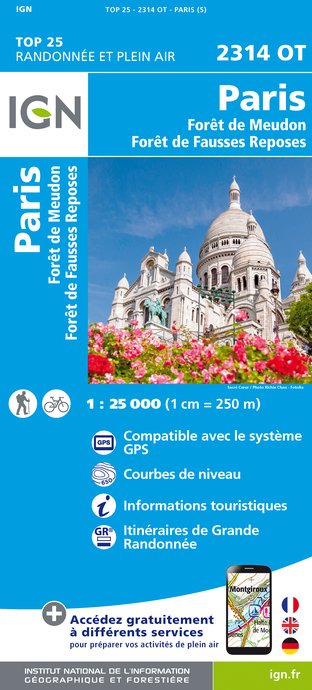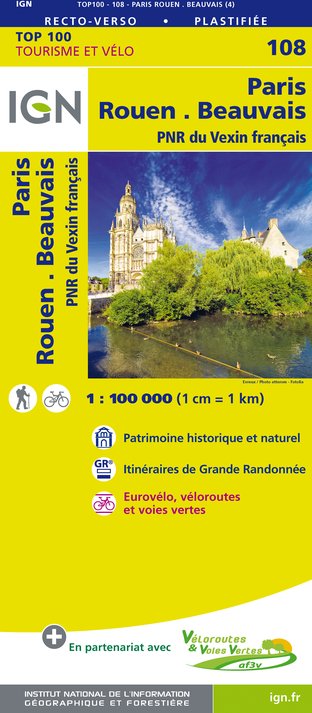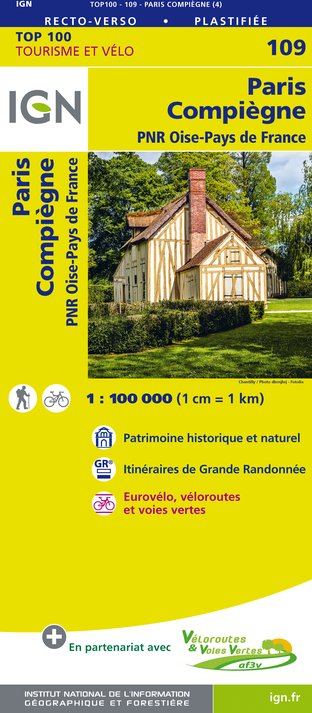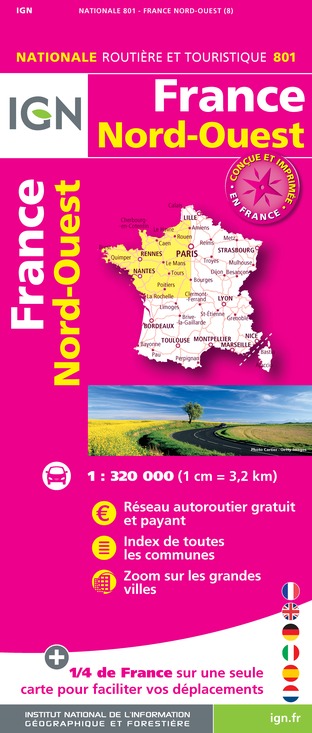Warnung
Warnungen
Art der Übung
Boot
Wandern
Fahrrad
Präsentation
Karte
Sehenswürdigkeiten
Cirkwi Kurzbeschreibung
Bewertungen und Rezensionen
In der Umgebung sehen
Paris mit dem Batobus



Kredit : Batobus
Die Cirkwi Kurzbeschreibung
Erkunden Sie Paris auf dem Wasser: Entdecken Sie die Batobus-Route
Zusammengestellt von Balades Fluviales Fabienne Lemoine, dem Gründer, bietet die Batobus-Tour ein einzigartiges Pariser Erlebnis, während Sie entlang der Seine gleiten. Verabschieden Sie sich von dem typischen Trubel städtischer Touren und erleben Sie eine ruhige Reise, die ikonische Sehenswürdigkeiten mit der Leichtigkeit des Flussverkehrs verbindet. Diese Reise führt durch das Herz von Paris, vom majestätischen Eiffelturm bis zum kulturellen Leuchtturm des Trocadéro. Es ist eine Einladung, Pariser architektonische Wunder und den Rhythmus des Flusses zu beobachten - eine Erzählung, die für diejenigen geschaffen wurde, die die Essenz der Stadt in Ruhe entdecken möchten.
Technische Einblicke in die Route
Ein kompletter Rundgang erstreckt sich über 9,8 Kilometer, mit subtilen Höhenunterschieden zwischen 27 und 30 Metern. Die Reise beinhaltet nur geringe positive und negative Höhenunterschiede von insgesamt 11 Metern, was sie bemerkenswert flach macht. Diese Informationen unterstreichen einen zugänglichen und gemütlichen Weg, der ideal für Besucher jeden Alters geeignet ist und eine bequeme Erkundung der malerischen Ufer und architektonischen Schätze von Paris ohne körperliche Anstrengung verspricht.
Jahreszeitliche Tipps für die Batobus-Reise
Unabhängig von der Jahreszeit ist das Batobus-Erlebnis bezaubernd. Im Frühling und Herbst herrscht mildes Wetter, was Ihre gemütlichen Spaziergänge am Pier verstärkt. Für Sommerreisende sind Sonnenschutz und ausreichende Flüssigkeitszufuhr wichtig, da der Reiz des Flusses am hellsten unter der Strahlkraft der Sonne ist. Winterreisende sollten sich warm anziehen, um sicherzustellen, dass die Kälte nicht von der Schönheit der beleuchteten Abende von Paris ablenkt. In Bezug auf die Sicherheit sollten Sie immer auf Ihre Umgebung achten und den Anweisungen der Crew folgen, insbesondere beim Ein- und Aussteigen.
Paris, Herz der französischen Kultur und Geschichte
Paris ist nicht nur die Hauptstadt Frankreichs, sondern auch ein historisches Geflecht, das die globale Kultur, Kunst und Politik seit Jahrhunderten beeinflusst hat. Es liegt in der Region Île-de-France und seine Ufer an der Seine haben entscheidende Momente von der Französischen Revolution bis zu bahnbrechenden Weltausstellungen miterlebt. Diese Stadt, die Freiheit, Kreativität und Widerstandsfähigkeit verkörpert, präsentiert sich majestätisch, während man entlang ihrer Lebensader, der Seine, wandert und Monumente sieht, die Geschichten von Triumph, Tragödie und Transformation erzählen.
Verständnis des Pariser Klimas für Reisende
Paris hat ein gemäßigtes Klima mit milden Wintern und angenehm warmen Sommern. Die Stadt erlebt das ganze Jahr über gleichmäßige Niederschläge, gelegentlich auch Schneefall im Winter. Die beste Zeit, um eine Batobus-Tour zu genießen, unter Berücksichtigung des Klimas, wäre der späte Frühling bis zum frühen Herbst (Mai bis September), wenn das Wetter am besten für Sightseeing geeignet ist und das oberste Deck unter minimalen Regenunterbrechungen genossen werden kann. Ein angenehmer Temperaturbereich ermöglicht ausgedehnte Erkundungen der Flussufer und angrenzender Sehenswürdigkeiten.
Zusammengestellt von Balades Fluviales Fabienne Lemoine, dem Gründer, bietet die Batobus-Tour ein einzigartiges Pariser Erlebnis, während Sie entlang der Seine gleiten. Verabschieden Sie sich von dem typischen Trubel städtischer Touren und erleben Sie eine ruhige Reise, die ikonische Sehenswürdigkeiten mit der Leichtigkeit des Flussverkehrs verbindet. Diese Reise führt durch das Herz von Paris, vom majestätischen Eiffelturm bis zum kulturellen Leuchtturm des Trocadéro. Es ist eine Einladung, Pariser architektonische Wunder und den Rhythmus des Flusses zu beobachten - eine Erzählung, die für diejenigen geschaffen wurde, die die Essenz der Stadt in Ruhe entdecken möchten.
Technische Einblicke in die Route
Ein kompletter Rundgang erstreckt sich über 9,8 Kilometer, mit subtilen Höhenunterschieden zwischen 27 und 30 Metern. Die Reise beinhaltet nur geringe positive und negative Höhenunterschiede von insgesamt 11 Metern, was sie bemerkenswert flach macht. Diese Informationen unterstreichen einen zugänglichen und gemütlichen Weg, der ideal für Besucher jeden Alters geeignet ist und eine bequeme Erkundung der malerischen Ufer und architektonischen Schätze von Paris ohne körperliche Anstrengung verspricht.
Jahreszeitliche Tipps für die Batobus-Reise
Unabhängig von der Jahreszeit ist das Batobus-Erlebnis bezaubernd. Im Frühling und Herbst herrscht mildes Wetter, was Ihre gemütlichen Spaziergänge am Pier verstärkt. Für Sommerreisende sind Sonnenschutz und ausreichende Flüssigkeitszufuhr wichtig, da der Reiz des Flusses am hellsten unter der Strahlkraft der Sonne ist. Winterreisende sollten sich warm anziehen, um sicherzustellen, dass die Kälte nicht von der Schönheit der beleuchteten Abende von Paris ablenkt. In Bezug auf die Sicherheit sollten Sie immer auf Ihre Umgebung achten und den Anweisungen der Crew folgen, insbesondere beim Ein- und Aussteigen.
Paris, Herz der französischen Kultur und Geschichte
Paris ist nicht nur die Hauptstadt Frankreichs, sondern auch ein historisches Geflecht, das die globale Kultur, Kunst und Politik seit Jahrhunderten beeinflusst hat. Es liegt in der Region Île-de-France und seine Ufer an der Seine haben entscheidende Momente von der Französischen Revolution bis zu bahnbrechenden Weltausstellungen miterlebt. Diese Stadt, die Freiheit, Kreativität und Widerstandsfähigkeit verkörpert, präsentiert sich majestätisch, während man entlang ihrer Lebensader, der Seine, wandert und Monumente sieht, die Geschichten von Triumph, Tragödie und Transformation erzählen.
Verständnis des Pariser Klimas für Reisende
Paris hat ein gemäßigtes Klima mit milden Wintern und angenehm warmen Sommern. Die Stadt erlebt das ganze Jahr über gleichmäßige Niederschläge, gelegentlich auch Schneefall im Winter. Die beste Zeit, um eine Batobus-Tour zu genießen, unter Berücksichtigung des Klimas, wäre der späte Frühling bis zum frühen Herbst (Mai bis September), wenn das Wetter am besten für Sightseeing geeignet ist und das oberste Deck unter minimalen Regenunterbrechungen genossen werden kann. Ein angenehmer Temperaturbereich ermöglicht ausgedehnte Erkundungen der Flussufer und angrenzender Sehenswürdigkeiten.
Automatisch generiert.
IGN Karten

2314OT - PARIS FORÊT DE MEUDON FORÊT DE FAUSSES REPOSES
Herausgeber : IGN
Sammlung : TOP 25 ET SÉRIE BLEUE
Leiter : 1:25 000
13.90€

190 PARIS CHANTILLY FONTAINEBLEAU
Herausgeber : IGN
Sammlung : TOP 100
Leiter : 1:100 000
8.40€

118 PARIS CHARTRES PNR DE LA HAUTE VALLÉE DE CHEVREUSE
Herausgeber : IGN
Sammlung : TOP 100
Leiter : 1:100 000
8.40€

108 PARIS ROUEN BEAUVAIS PNR DU VEXIN FRANÇAIS
Herausgeber : IGN
Sammlung : TOP 100
Leiter : 1:100 000
8.40€

109 PARIS COMPIÈGNE PNR OISE-PAYS DE FRANCE
Herausgeber : IGN
Sammlung : TOP 100
Leiter : 1:100 000
8.40€

D75-95 ÎLE-DE-FRANCE OUEST
Herausgeber : IGN
Sammlung : CARTES DÉPARTEMENTALES IGN
Leiter : 1:150 000
5.90€

D77 SEINE-ET-MARNE
Herausgeber : IGN
Sammlung : CARTES DÉPARTEMENTALES IGN
Leiter : 1:150 000
5.90€

D28 EURE-ET-LOIR
Herausgeber : IGN
Sammlung : CARTES DÉPARTEMENTALES IGN
Leiter : 1:150 000
5.90€

NR01 HAUTS-DE-FRANCE
Herausgeber : IGN
Sammlung : CARTES RÉGIONALES IGN
Leiter : 1:250 000
6.80€

NR08 CENTRE-VAL DE LOIRE
Herausgeber : IGN
Sammlung : CARTES RÉGIONALES IGN
Leiter : 1:250 000
6.80€

NR03 ÍLE DE FRANCE
Herausgeber : IGN
Sammlung : CARTES RÉGIONALES IGN
Leiter : 1:250 000
6.80€

801 FRANCE NORD OUEST
Herausgeber : IGN
Sammlung : CARTES NATIONALES IGN
Leiter : 1:320 000
6.10€

EUROPE
Herausgeber : IGN
Sammlung : DÉCOUVERTE DES PAYS DU MONDE IGN
Leiter : 1:2 500 000
7.00€
Technische Informationen
Boot
Schwierigkeit
Nicht angegeben
Entfernung
9.9 km
Art der Übung
Boot
Wandern
Fahrrad
Mehr anzeigen
Höhenprofil
Ausgangspunkt
75007
Paris
Lat : 48.861687Lng : 2.295842
Sehenswürdigkeiten
Datenautor
Bewertungen und Rezensionen
In der Umgebung sehen








